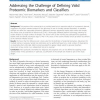Free Online Productivity Tools
i2Speak
i2Symbol
i2OCR
iTex2Img
iWeb2Print
iWeb2Shot
i2Type
iPdf2Split
iPdf2Merge
i2Bopomofo
i2Arabic
i2Style
i2Image
i2PDF
iLatex2Rtf
Sci2ools
BMCBI
2010
2010
Addressing the Challenge of Defining Valid Proteomic Biomarkers and Classifiers
Background: The purpose of this manuscript is to provide, based on an extensive analysis of a proteomic data set, suggestions for proper statistical analysis for the discovery of sets of clinically relevant biomarkers. As tractable example we define the measurable proteomic differences between apparently healthy adult males and females. We choose urine as body-fluid of interest and CE-MS, a thoroughly validated platform technology, allowing for routine analysis of a large number of samples. The second urine of the morning was collected from apparently healthy male and female volunteers (aged 21-40) in the course of the routine medical check-up before recruitment at the Hannover Medical School. Results: We found that the Wilcoxon-test is best suited for the definition of potential biomarkers. Adjustment for multiple testing is necessary. Sample size estimation can be performed based on a small number of observations via resampling from pilot data. Machine learning algorithms appear ide...
| Added | 28 Feb 2011 |
| Updated | 28 Feb 2011 |
| Type | Journal |
| Year | 2010 |
| Where | BMCBI |
| Authors | Mohammed Dakna, Keith Harris, Alexandros Kalousis, Sebastien Carpentier, Walter Kolch, Joost P. Schanstra, Marion Haubitz, Antonia Vlahou, Harald Mischak, Mark Girolami |
Comments (0)

